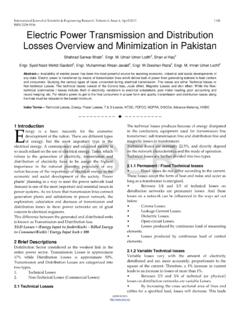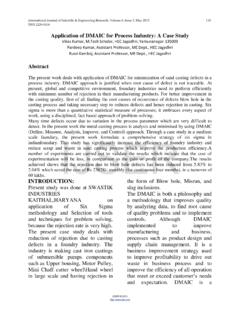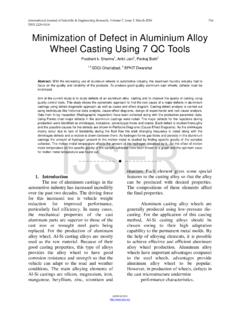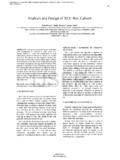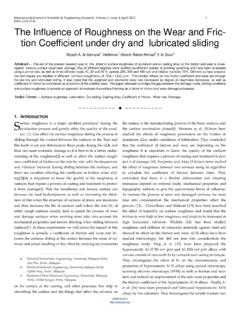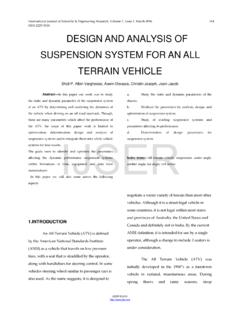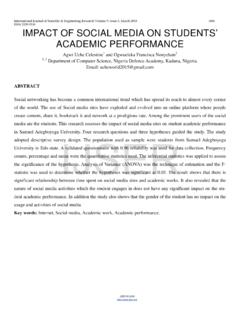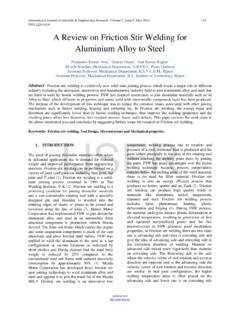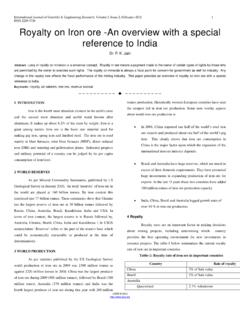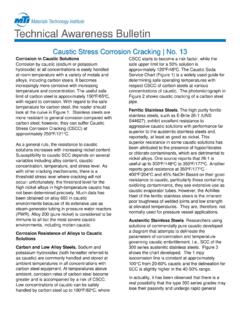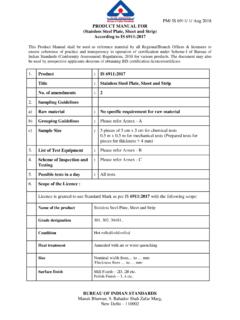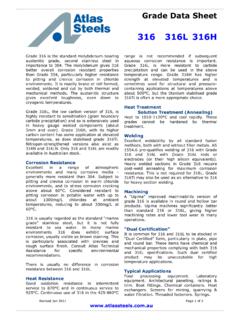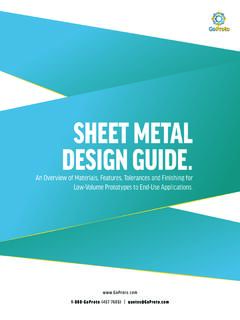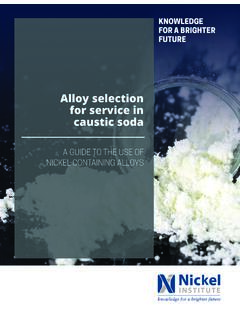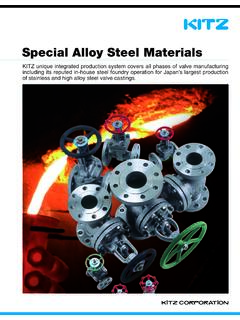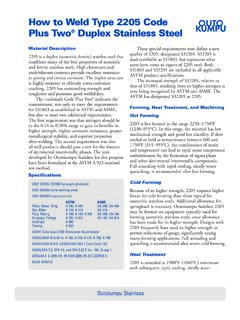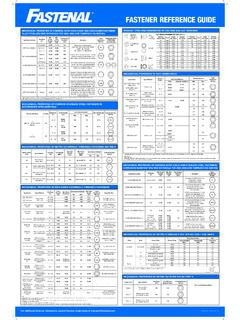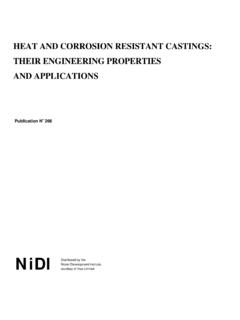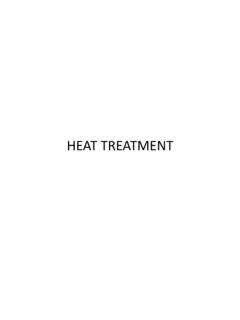Transcription of Processing Techniques and Productions of Ductile Iron: A ...
1 International Journal of Scientific & Engineering Research, Volume 7, Issue 9, September-2016 397 ISSN 2229-5518 IJSER 2016 Processing Te c hniques and Productions of Ductile Iron: A Review Olawale, Ibitoye, Oluwasegun Abstract Ductile cast irons are materials having strength, impact toughness and ductility comparable to those of many grades of steel while exceeding by far those of standard gray irons. In addition, they have the same advantages of design flexibility and low cost casting procedures of cast irons. Their corrosion resistance is equal or superior to that of gray cast iron and cast steel in many corrosive environments. Its wear resistance is comparable to some of the best grades of steel and superior to gray iron under heavy load or in impact situations. They are considerably less expensive than cast steels to produce and only moderately more expensive than gray cast irons because the procedures are similar.
2 The combination of good mechanical properties and casting abilities of Ductile cast iron makes it economical choice for many applications. Practical examples are valves, pumps, cylinder liners, crankshafts, metal working rolls, dies, gears, process equipment and structural applications. This paper reviews the process Techniques and applications of Ductile cast irons. Index Terms Ductile iron, Graphite, Spherodizing, Inoculation, Flakes, Nodules, Nodularizer 1 INTRODUCTION uctile iron is a ferrous alloy consisting primarily of iron with carbon and silicon. Other elements are also present and controlled to produce the various grades and to influence other mechanical properties, machinability, and castability. Carbon is added to iron in amounts that exceed the solubility limit, and during solidification, graphite precipitates into tiny spheres.
3 Silicon and other alloys are used to control the mor-phology of the precipitated graphite and to control the amount of carbon that remains as a solid solution in the iron. The carbon content is typically between 3 4% and the silicon content between 2 3% which gives a eutectic solidification temperature of about 1165 C. The amount of carbon that re-mains in solid solution depends on the rate of solidification and cooling, on the inoculation practice, and on other elements that are added to either promote graphitization or to promote the formation of pearlite. It is possible to produce the different grades of Ductile iron by controlling the process variables to precipitate the desired amount of graphite particles and obtain the desired amount of combined carbon remaining in the ma-trix [1]. Ductile iron was invented in the mid 1940 s somewhat by ac-cident when a metallurgist was trying to find a replacement for chrome in wear-resistant gray iron castings.
4 Magnesium was used in one of the experiments, and it was discovered that what were normally flake graphite shapes were now sphe-roidal. Castings made with spheroidal rather than flake gra-phite had high strength and ductility, good fatigue life, and impact properties. Other properties such as vibration damp-ing, machinability, and wear resistance have made Ductile iron a suitable replacement for steel in gears and a number of other applications. The main structural difference between nodular cast iron and gray cast iron is in the graphite form. Ordinary gray cast iron is characterized by a distribution of random lamellae of gra-phite in the metal matrix, while in nodular cast iron the gra-phite has the form of small spheroids. With respect to lamel-lae, the spheroids create fewer and less severe discontinuities in the metal matrix thus producing a stronger, more Ductile cast material [2].
5 This new form of cast iron immediately found uses where malleable iron, forgings, cast steel or steel fabrications would have been used. From this point, Ductile cast iron grew into a world class material offering cast solu-tions at a competitive price compared to traditional alterna-tives. The advantages of Ductile iron which have led to its success are numerous, but they can be summarized easily - versatility and higher performance at lower cost. Other members of the ferrous casting family may have individual properties which might make them the material of choice in some applications, but none have the versatility of Ductile iron, which often pro-vides the designer with the best combination of overall prop-erties [3-6]. This versatility is especially evident in the area of mechanical properties where Ductile iron offers the designer the option of choosing high ductility, with grades guarantee-ing more than 18% elongation, or high strength, with tensile strengths exceeding 825 MPa [7], [8].
6 In addition to the cost advantages offered by all castings, duc-tile iron, when compared to steel and malleable iron castings, also offers further cost savings. Like most commercial cast metals, steel and malleable iron decrease in volume during D Dr. Olawale is currently a Lecturer I in the Department of Materials Science and Engineering, Obafemi Awolowo University, Nigeria, PH-+2348034289578. E-mail: Prof. Ibitoye is currently a Professor in the Department of Materials Science and Engineering, Obafemi Awolowo University, Nigeria, PH-+2347030305596. E-mail: Dr. Oluwasegun is currently a Lecturer I in the Department of Ma-terials Science and Engineering, Obafemi Awolowo University, Nigeria, PH-+2347035552287. E-mail: IJSERI nternational Journal of Scientific & Engineering Research, Volume 7, Issue 9, September-2016 398 ISSN 2229-5518 IJSER 2016 solidification, and as a result, require attached reservoirs (feeders or risers) of liquid metal to offset the shrinkage and prevent the formation of internal or external shrinkage defects.
7 The formation of graphite during solidification causes an in-ternal expansion of Ductile iron as it solidifies and as a result, it may be cast free of significant shrinkage defects either with feeders that are much smaller than those used for malleable iron and steel or, in the case of large castings produced in rigid moulds, without the use of feeders [9]. The reduction or elimi-nation of feeders can only be obtained in correctly designed castings. This reduced requirement for feed metal increases the productivity of Ductile iron and reduces its material and energy requirements, resulting in substantial cost savings. The use of the most common grades of Ductile iron "as-cast" elimi-nates heat treatment costs, offering a further advantage. Ductile iron is not a single material, but a family of materials offering a wide range of properties obtained through micro-structural control. The common feature that all Ductile irons share is the roughly spherical shape of the graphite nodules.
8 With a high percentage of graphite nodules present in the structure, mechanical properties are determined by the Ductile iron matrix. A number of variables including chemical compo-sition, cooling rate, type, amount and method of post inocula-tion, amount of residual magnesium and pouring temperature can control the matrix structure of Ductile iron [10]. The im-portance of matrix in controlling mechanical properties is em-phasized by the use of matrix names to designate the Ductile iron as ferritic , pearlitic and ferritic -pearlitic Ductile iron with graphite spheroids in a matrix of ferrite, pearlite and ferrite-pearlite respectively [11]. Over the years a number of process parameters have been de-veloped to introduce magnesium into gray cast iron to change its morphology from graphite flakes to nodules. The most common process Techniques in use today are: plunging, autoc-lave/pressure ladle, treatment converter, cored wire, open ladle, sandwich, tundish, porous plug, in-mould, and flow-through.
9 This review reports the extensive production process of these Techniques and the applications of Ductile cast iron. 2 PRODUCION OF Ductile IRON Ductile iron is made by the treatment of molten iron with no-dulizing (spheroidizing) material. During this treatment, gra-phite changes from flakes to nodules or spheres. The treatment process is a key operation in the production of Ductile iron that ensures a predetermined microstructure, and mechanical and engineering properties of castings. production of Ductile iron is influenced by a large number of metallurgical, technological, heat transfer and designing pa-rameters. The first step of the production of Ductile iron cast-ings is the careful selection of the charge materials. Manganese and chromium have the most influence on all mechanical properties [12]. For this reason, their concentration in metal is of particular importance. These elements arise in the charge from steel scrap, pig iron and foundry returns.
10 It is a recom-mended practice to select steel scrap so that the average Cr content remains below Ideally, the same advice would be given for Mn but, unfortunately, all steel scraps contain Mn, the majority being at level. The amount of steel scrap in the charge must be such that the castings produced are free of carbides as much as possible [13]. It is particularly important for the production of ferritic Ductile iron [14]. Charge materials result in the average size of graphite sphero-ids. For instance, if the amount of steel scrap in the charge is higher than 50%, then an average spheroids diameter is 33 m and if it is 30%, then the average diameter is 57 m [15]. The amount of steel scrap affects metallic matrix structure too. It increases the pearlite formation [16]. The graphite structure is affected by the carbon content as well. If initial metal does not contain enough carbon then gra-phite particles will be of compact shape [17].
